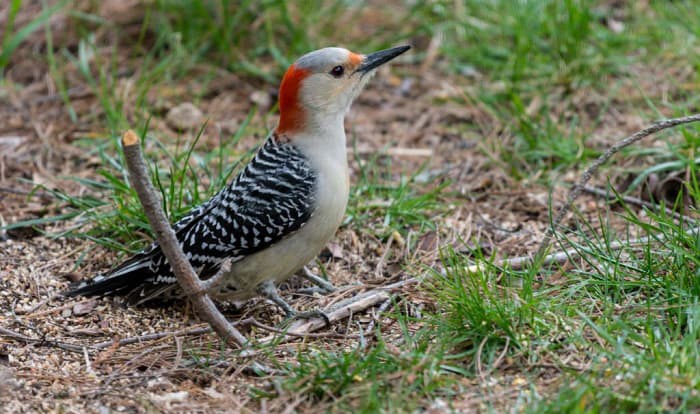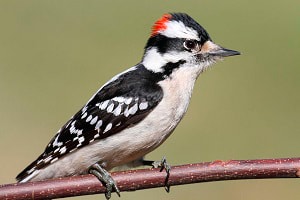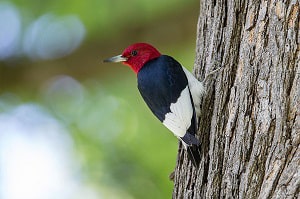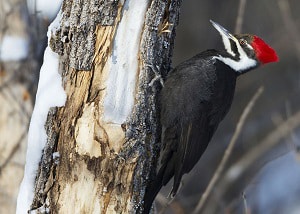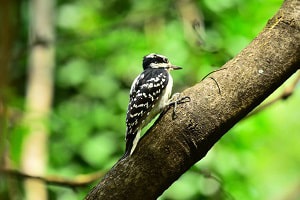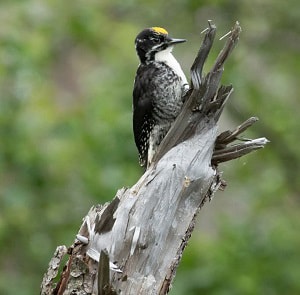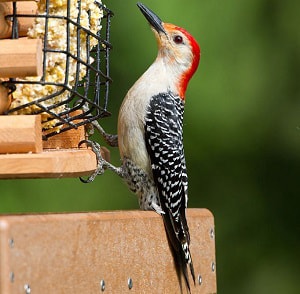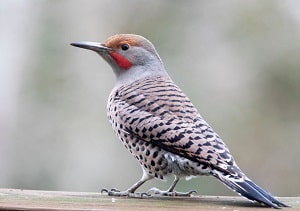There are 10 species of woodpeckers in Michigan that thrive in the state’s hills, flatland, parks, and lakes. The Great Lake State is proud to have beautiful woodpeckers stay there and breed in the spring and summer.
These bird species include the downy woodpecker, American three-toed woodpecker, pileated woodpecker, hairy woodpecker, red-bellied woodpecker, and more.
These birds have their own behavior, breeding process, and feeding habits. But they all come from the same family.
Table of Contents
List of Michigan Woodpeckers
In Michigan, there are small, medium-sized, and large woodpeckers inhabiting dead and alive trees. They survive by eating insects, both from mid-air and on trees.
Some of these birds are migrants, and a few are year-round residents of the state. And when it’s time to breed, they either dig their own tree holes or reuse abandoned tree cavities.
Learning about these woodpeckers makes it seamless for you to identify them when you see one or two.
1. Downy Woodpecker
The downy woodpecker is the smallest bird in its family. They represent courage and hard work due to their behavior in finding food, nesting, and protecting their young.
Humans love them because they are friendly, and they often visit bird feeders and birdbaths. This woodpecker breed is often mistaken for the hairy woodpeckers because of their similar appearance.
Downy woodpeckers have black wings, white backs, breasts, and bellies. Males are blessed with a red head spot, while females have white lines. They’re small at 5-7”, and their bills are tiny and thin, unlike the longer and thicker beaks of the hairy woodpeckers.
After a year of existence, the downy woodpeckers can start breeding. One clutch has 4-5 eggs, and the incubation period is 12 days. The young birds leave their parents after about 30 days.
These woodpeckers drum on trees up to 10 times every 60 seconds. But thanks to the special nostril feathers, they’re safe from the granules or tiny debris of trees. More importantly, their brains are shock-proof from the constant hammering.
2. Red-headed Woodpecker
Thanks to the red headed woodpecker Michigan residents get to witness the striking beauty of avians. Obviously, this bird got its name from its physical appearance. And they even have cute nicknames such as “patriotic bird” and “flag bird”.
The red-headed woodpeckers have a length of 7.5-9.8”, wingspan of 16.7”, and weigh 56-97g. Their heads, upper chests, and napes are red, while the rest of the chests and bellies are white. These birds have lengthy, blue-black tails. And both sexes look similar to each other.
This woodpecker species is naturally solitary, and they like the open woodlands and grasslands. They thrive in dead trees, especially for nesting by digging holes with their sturdy bills. Red-headed woodpeckers are monogamous, and both parents perform the egg incubation.
Once the eggs are hatched, males and females forage for food to feed their baby birds. Both parents defend their chicks until they leave the nests after 24-27 days. However, their number is declining.
3. Pileated Woodpecker
The pileated woodpecker is the largest woodpecker with a length of 16-19”. They are named this way because of their red head cap. Their beaks look like chisels, and their vivid black and white shades add to their beauty.
Unlike other bird species in the world, the pileated woodpeckers choose their territories and defend them all year. They live and breed in the same spot, and stay there even when the juveniles have flown out on their own.
Carpenter ants are the favorite food of the pileated woodpeckers. In fact, 40-97% of their diet consists of these protein-rich ants. And the good news for other birds is, this woodpecker breed contributes to their meal sources.
While the pileated woodpeckers drum on trees, other birds are able to catch escaping insects and feed on them.
In order to survive, this bird species adapts to their environment in terms of their diet. When the scarcity of insects and bugs occurs, they turn to seeds and nuts. And so in the winter months, bird feeders receive many of these flying visitors.
4. Hairy Woodpecker
For any hairy woodpecker Michigan is a home where they live and breed. They are medium-sized birds at 9-13” long and a weight of 43-99g.
These woodpeckers have beaks the same length as their heads. And their bodies have a black shade with white lines, which are similar in appearance to the downy woodpeckers.
Hairy woodpeckers love insects, and they drum consistently on trees in order to feed. Fortunately, their nostrils and brain are protected from shock and tree fibers. Plus, their four toes enable them to exert a strong grip on trees. And so, tapping on tree barks and excavating holes is not a problem for this bird species.
The breeding season of hairy woodpeckers is February to June. Males dig their nesting holes to allow their female mates to lay 2-5 eggs. And for two weeks, both parents take turns incubating the eggs. The young woodpeckers then leave the nest in 28-30 days.
It’s not clear how long hairy woodpeckers can survive in the wild.
5. American Three-toed Woodpecker
The American three-toed woodpeckers have a black and white pattern, like typical woodpeckers. But what sets them apart are their three toes instead of the regular four.
They are quiet creatures that can hang on trees without other birds or people noticing. And they help the ecosystem by consuming tree beetles that plague the woodlands.
Birders can usually see pairs of these woodpeckers searching for food, but they become solitary foragers during the breeding season.
They build their nest in tree cavities, both dead and alive, as well as in utility poles. And their nests are located 5-15’ off the earth, typically in conifer trees.
Females generate 3-6 eggs while nesting, which are incubated by both parents for two weeks. Baby birds get their sustenance from parents and are protected by them too. And after 22-26 days or 4-8 weeks, juveniles leave their parents’ side.
Three-toed woodpeckers often move south during migration.
6. Red-bellied Woodpecker
There are 10 types of Michigan woodpeckers, and the red-bellied woodpecker is one of them. Their population is about 10 million all over the world, with a lifespan of 12 years. This avian species weighs 56-91g, with a length of 22-26cm, and wingspan of 38-46cm.
Red-bellied woodpeckers have black and white shade on their wings, back, and tails. They have pale gray underparts and red heads. Though their name implies a scarlet belly, it’s actually not easy to spot the red on that part of the body.
These non-migratory birds prefer deciduous forests, but they also hang out in metropolitan areas, gardens, plantations, and orchards. They feed on insects, berries, and nuts, and doing so is quite easy thanks to their bills and lengthy tongues.
During the breeding season in May, both partners dig holes in dead or alive trees for their nest. And then females produce 3-8 eggs. The incubation period is 12-14 days, and juveniles fend for themselves at their 51st to 53rd day of existence.
7. Northern Flicker
The Northern flicker is a small woodpecker with a length of 28-31cm, weight of 110-160g, and wingspan of 42-51cm. They differ from the rest of their family because of their brown and black hues. And males have a distinctive dark or crimson mustache, which is absent in females.
These bird species are 9-16 millions in population, and they are expected to live for 9 years. They prefer to stay in open areas, parks, orchards, woodland edges, and agricultural fields. These woodpeckers are not very social, but they get along well with other birds while searching for food.
Northern flickers are monogamous in nature, and their breeding months are in February to July. Their nests are often located in trees, electrical posts, and yard birdhouses. Each clutch consists of 6-8 white eggs, which require 11-12 days of incubation by both adults.
The altricial baby birds start to cling to the nest walls at 17 days. And then on their 25th to 28th day after hatching, they fly out with the continued guidance of their parents.
8. Yellow-bellied Sapsucker
Yellow-bellied sapsuckers are Northern Michigan woodpeckers that have an overall population of 14 million worldwide. Their lifespan is 6-8 years, with a length of 19-21cm, weight of 35-62g, and wingspan of 34-40cm.
Males have a vivid scarlet head patch while females have a duller hue. They also have a crimson chin and throat, whereas females have white ones.
The black and white bar pattern of this type of bird makes them similar to other woodpecker species. And though their bills are short, they are enough to help these feathered creatures forage for food, excavate holes, and feed their young.
They frequent woodlands and open areas where they feed alone, in pairs, or in small flocks.
Yellow-bellied sapsuckers are fond of insects, but they also eat tree sap, fruits, nuts, tree bast, buds, and berries.
And in the breeding season, males and females mate for life. 4-7 eggs are laid per clutch in April to July, and are incubated for 10-13 days. And after 5.5-6 weeks, the young woodpeckers gain their independence.
9. Black-backed Woodpecker
The identification of the black-backed woodpeckers is easy, since they have blacker colors compared to their cousins. They have a yellow marking on their heads, and their black face has white lines. These avian species are dominant by nature, and they simply love burnt woodlands.
Black-backed woodpeckers forage for insects in dead trees and nest in tree holes as well. Females generate 2-6 eggs, and their mates are responsible enough to help with the incubation for 12-14 days.
After hatching, both parents feed and defend their baby birds. And in their 25th day of existence, the juveniles leave their tree cavities.
10. Lewis’s Woodpecker
Some of the male and female woodpeckers that are found in Michigan are Lewis’s woodpeckers, though they’re rarely sighted. They got their name from the explorer Meriwether Lewis. Unlike other woodpeckers, this bird species catches insects mid-air instead of by drumming on trees.
The Lewis’s woodpecker is a medium-sized bird with a dark scarlet face, greenish-black hood, light crimson belly, black feet, legs, and beaks, and gray collar.
These woodpeckers don’t excavate their own holes. They instead reuse tree cavities for roosting and nesting. When nesting, the females produce 5-9 opaque white eggs, with an incubation period of 12-16 days. And then later after 28-34 days, the juveniles are ready to fly out on their own.
Conclusion
Learning about the 10 species of woodpeckers in Michigan is a great way to pinpoint what kind of bird you see. Knowing them will turn you into an expert birder. And gaining the knowledge on where these woodpeckers roost and nest allows you to find them easily.
Kindly let us know what you think about this article. We always welcome comments, suggestions, and ideas from our readers. And please help us spread this informative post to your social media, as well as friends.
Furthermore, don’t forget to check other interesting articles on birds:
- What are the species of woodpeckers in Arizona and Maryland?
- The state bird of Michigan and its facts.

George and I became friends after a birdwatching trip with our new group. And we have been enjoying every adventure together. When he told me the idea of establishing a site that shares our experiences and fun, I immediately agreed. After trials and errors, here we have Thayerbirding.


